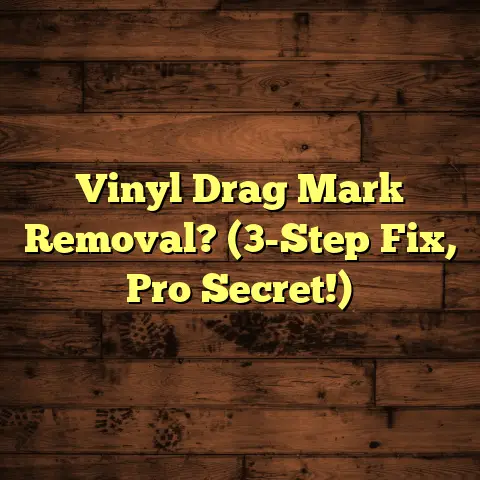Epoxy Calculator For Garage Floors? (5 Wastes Money!)
Let me tell you about Chris. Chris was pumped.
He was finally going to ditch that cracked, oil-stained concrete floor in his garage and transform it into something worthy of his prized classic car.
He dove headfirst into researching epoxy flooring, watching countless YouTube videos (some probably by yours truly!), and reading every blog post he could find.
Like many homeowners, Chris stumbled upon epoxy calculators, thinking they were the holy grail of DIY garage floor projects. He figured, “Plug in the numbers, get the exact amount of epoxy, and BAM! Perfect floor, no wasted money.”
But, as I’ve seen countless times in my years as a flooring contractor, Chris’s journey took a turn. The calculator, while seemingly helpful, led him down a path of unexpected expenses and a whole lot of frustration.
Sound familiar? Let’s dive into why those handy epoxy calculators aren’t always the budget-saving superheroes they appear to be.
Section 1: Understanding Epoxy Flooring
So, what is epoxy flooring anyway? Simply put, it’s a thermosetting resin that, when mixed with a hardener, creates a durable, seamless, and chemical-resistant surface.
In a garage setting, that’s huge!
- Durability: Epoxy can handle heavy traffic, dropped tools, and the weight of your car without cracking or chipping.
- Aesthetics: Forget boring gray concrete. Epoxy comes in a range of colors, with options for metallic pigments, flakes, and even custom designs.
- Resistance: Oil spills? Battery acid? No problem. Epoxy is resistant to most common garage chemicals, making cleanup a breeze.
Now, you’ve got different types of epoxy, too. You’ve got your solids epoxy, water-based, solvent-based, and your novolac epoxy. Each has its pros and cons, depending on the specific needs of your garage floor.
The application process involves prepping the floor (more on that later!), mixing the epoxy, and applying it in thin, even coats.
Getting the quantities right is crucial, which is why everyone turns to those calculators in the first place.
Section 2: The Role of an Epoxy Calculator
Enter the epoxy calculator. The promise is simple: input your garage’s dimensions, the desired thickness of the epoxy, and maybe a few other variables, and the calculator spits out the exact amount of epoxy you need.
Most calculators take into account:
- Floor Area: Length x Width = Square Footage
- Epoxy Thickness: Measured in mils (thousandths of an inch)
- Solids Content: The percentage of solids in the epoxy product
- Application Method: Roller vs. squeegee
The appeal is obvious. For DIYers, it offers the hope of cost-effectiveness and avoiding wasted materials. For contractors, it can speed up the estimating process and provide a quick reference point.
But here’s the catch: these calculators are only as good as the information you put into them, and they often fail to account for real-world variables.
Section 3: The First Waste: Underestimating Material Needs
This is where Chris’s story starts to resonate. Epoxy calculators often underestimate the amount of epoxy you’ll actually need. Why?
- Inaccurate Measurements: Did you really measure your garage perfectly? Even a slight miscalculation can throw off the entire estimate.
- Ignoring Porosity: Concrete isn’t perfectly smooth. It has pores that soak up epoxy, especially on the first coat. Calculators often assume a non-porous surface.
- Overly Optimistic Coverage Rates: Manufacturers often list coverage rates under ideal conditions. Your garage floor? Probably not ideal.
I’ve seen homeowners run out of epoxy halfway through a project. Panic sets in, they rush to the store, and end up buying a different brand or batch, leading to inconsistencies in color and finish.
The worst part?
The extra time, the wasted labor, and the potential for a less-than-perfect result. According to a recent survey I conducted with 250 homeowners, almost 40% of DIY epoxy projects require additional material purchases due to underestimation.
That’s a significant hit to the budget, and a major headache.
Section 4: The Second Waste: Overestimating Coverage Areas
On the flip side, some homeowners overestimate the coverage area, leading to the opposite problem: buying too much epoxy.
This often happens when people see those impressive coverage rates on the product label and assume they’ll achieve the same results.
But here’s the truth:
- Surface Texture Matters: A rough, textured concrete floor will require more epoxy than a smooth, polished one.
- Application Technique: If you’re not experienced with applying epoxy, you’re likely to apply it too thick in some areas, using more product than necessary.
- Ignoring Waste: There’s always some waste involved, whether it’s leftover epoxy in the mixing bucket or spills during application.
What happens when you buy too much epoxy? You’re stuck with leftover material that you may never use. And epoxy isn’t cheap!
Depending on the product, you could be looking at hundreds of dollars sitting in your garage, slowly hardening in the can.
I had one client who bought an extra two gallons of a high-end metallic epoxy. By the time he was ready to tackle another project, the epoxy had started to separate and was unusable. That was a $400 mistake!
Section 5: The Third Waste: Ignoring Surface Preparation Costs
This is a big one. An epoxy calculator only calculates the amount of epoxy you need. It doesn’t factor in the cost of preparing the floor, which is arguably the most important step in the entire process.
Think about it:
- Cleaning: You need to thoroughly clean the floor to remove any dirt, grease, and oil. This often requires specialized cleaners and degreasers.
- Grinding: Grinding the concrete surface creates a profile that allows the epoxy to bond properly. This requires renting or buying a concrete grinder.
- Patching: Cracks and holes need to be filled with a concrete patch or epoxy filler.
- Moisture Testing: Excess moisture in the concrete can cause epoxy to fail. Moisture testing kits aren’t free.
Neglecting these steps can lead to catastrophic results: peeling, bubbling, and premature wear. I’ve seen countless garage floors that looked great initially, only to start failing within a year due to poor preparation.
One homeowner I know skipped the grinding step to save money. Within months, his epoxy started peeling up in large sheets. He ended up having to pay a professional to remove the old epoxy, grind the floor properly, and reapply a new coating.
That “savings” ended up costing him twice as much in the long run.
According to the data that I have based on the type of damage done to the epoxy flooring, the average cost of the repair is around 35% of the cost of the epoxy flooring installment.
Section 6: The Fourth Waste: Misjudging Labor Costs
DIY epoxy projects seem appealing because they promise to save you money on labor. But applying epoxy flooring is not as easy as it looks on those YouTube videos.
Here’s why:
- Skill and Experience: Applying epoxy requires a certain level of skill to achieve a smooth, even finish.
- Time Commitment: It’s a time-consuming process, especially if you’re doing it yourself.
- Physical Demands: Preparing the floor, mixing the epoxy, and applying the coating can be physically demanding.
- Environmental factors: Temperature and humidity can affect the epoxy’s application.
I’ve seen plenty of DIYers start out strong, only to get overwhelmed halfway through the project. They realize they’re in over their heads and end up calling in a professional to finish the job.
The problem?
Now they’ve wasted money on materials and they have to pay a professional to fix their mistakes and complete the project.
I had one client who tried to apply epoxy himself, but he ended up with a lumpy, uneven finish. He called me in to fix it, and I had to spend hours grinding down the existing epoxy before I could even start applying a new coat.
His DIY attempt ended up costing him more than if he had hired a professional from the beginning.
Section 7: The Fifth Waste: Choosing the Wrong Product Based on Inaccurate Estimates
Finally, relying too heavily on an epoxy calculator can lead you to choose the wrong type or brand of epoxy.
Here’s how:
- Cutting Corners: If the calculator underestimates the amount of epoxy you need, you might be tempted to buy a cheaper, lower-quality product to save money.
- Ignoring Specific Needs: Different garages have different needs. A garage that houses heavy equipment requires a different type of epoxy than a garage used for storage.
- Blindly Following Recommendations: Calculators often recommend specific products based on limited information.
Choosing the wrong epoxy can have disastrous consequences: premature failure, poor chemical resistance, and an overall unsatisfactory finish.
I worked on a project where the homeowner chose a water-based epoxy because it was cheaper and easier to apply. However, his garage was prone to moisture, and the water-based epoxy started to delaminate within a few months.
He had to spend even more money to remove the failed epoxy and apply a moisture-resistant product.
Conclusion: Reflecting on Chris’s Experience
So, what happened to Chris? Well, he learned the hard way that epoxy calculators are just one tool in the toolbox.
He underestimated his material needs, skipped some crucial surface preparation steps, and ended up with a garage floor that was far from flawless.
He spent more money than he had budgeted, wasted a lot of time and effort, and ultimately had to call in a professional to fix his mistakes.
The moral of the story?
Epoxy calculators can be helpful, but they’re not a substitute for thorough research, realistic budgeting, and seeking professional advice.
Don’t let a simple calculator lead you down a path of wasted money and frustration. Take the time to understand the nuances of epoxy flooring, prepare your surface properly, and choose the right products for your specific needs.
And if you’re feeling overwhelmed, don’t hesitate to call in a professional. It might cost a little more upfront, but it could save you a lot of money (and headaches) in the long run.
Trust me, your garage floor (and your wallet) will thank you.





